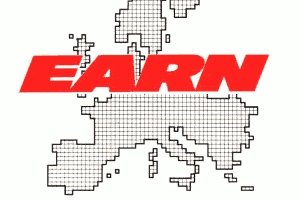EARN

European Academic Research Network
My first contact with telematic networks occurred in the year 1988 or 1989, I don't remember exactly. In that At that time I was studying Computer Science at UAB (Autonomous University of Barcelona), and I found out that the VAX with the one we students worked with had access to this network.
Even if I tried to find out, I never found out since when I had the university access to this network; What if I came to know is that the connection was made at the request of the department of High energy physics, which used it to keep in touch with the CERN , the European Laboratory for Nuclear Physics, located in Switzerland. Of In fact, EARN was taught to me by a colleague who worked as a intern in the Physics department, and that he had used it for things related to your work.
EARN was a network based on the IBM JNET protocol; in fact, it was this company who promoted and financed its development. Furthermore, this network was connected to its American counterpart, BITNET, which allowed the use of EARN to communicate with everything the world.
The JNET protocol was only supported by mainframes, initially by those of IBM, although there were ports for other systems, such as VAX / VMS from DEC company (currently Compaq ); for which there was no JNET port it was for PCs, so the only way we had to use this network was since the University VAX terminals.
The information available was very scarce, so we never I arrived to know in detail the structure and operation of the net. From what I was told, EARN was based on a network of point-to-point links and X25 lines, whose speeds oscillated between 9,600 baud and 64kb / s. The international connection, the one that connected Spain with the rest of the world, via a point-to-point line that communicated the UPC (Polytechnic University de Catalunya) in Barcelona, with the University of Motpellier , in France; line that, according to They told me, it was going to a whopping 64kb / s (I don't know if it's true; If anyone knows, I will appreciate it. clarify it for me. In Anyway, those who complain that their 56Kb / s modem is slow, let them know what we had at that time): DDDD
Yes, by current criteria, the EARN rates weren't exactly spectacular, the services is not that they were too; Yes indeed, for those of us who enjoyed them they were something extraordinary. The net, Basically, it offered three services; email, file sharing and chat. In the case of Spain, the management of these services was centralized in an IBM 3090 located in the CPU. The most used service was, of course, the chat; this service had the name RELAY , and it was a very primitive system, although its structure was like IRC ; that is to say, It was based on a network of chat servers that communicated with each other, and people could talk on the channels, or communicate in a private. For those who complain about lag on IRC, it should be noted that the trickle it was perfectly normal for a message to take more than a minute to Reach your destination; try to have a conversation with someone of Hispanoamerica could be really maddening
EARN's email service had no mysteries; Emails were sent using the standard VAX mail program, although the destination address should have a prefix indicating which was an EARN address. The funny thing was that, after sending the message, In the terminal you would see messages that indicated the nodes where your email it was happening. In EARN, unlike on the Internet, the message did not go directly from the initial node to the final node, but each node of the network sent it to the node next (in other words, to the computer at the other end of the cable), and the node that received the email sent a warning message to the terminal where this message had been originated; in this way, you could see the route that the message followed and, incidentally, know the structure of the red.
The file sharing service, named TRICKLE was something similar to an anonymous ftp, although it worked in a distributed way; that is, each server had a repository of files, and there was a general list with the files contained on all servers. When he wanted some program, he you sent to the server that you had assigned (in our case an IBM 3090 located in the UPC) a command requesting it, and within one or two days you received the file in your email. When receiving a request, the server consulted the list for the location of the file, and sent a request to the server to store it for you to send it to him. Once received, I would send it to user who requested it, and kept a copy for some time time, in case more people requested that same file (that is, that also acted as a file cache).
After the introduction of the Internet in 1990, EARN was languishing until its final closure, which, if I remember correctly, occurred in 1992.

